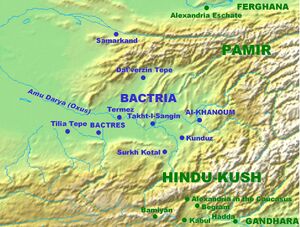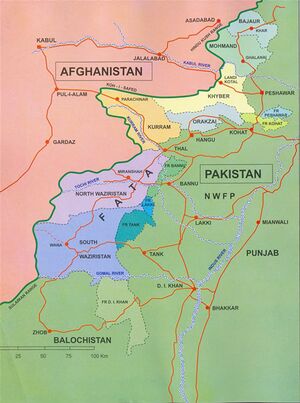Hidda
| Author:Laxman Burdak, IFS (R) |


Hidda (हिद्दा) is a small village, 5 miles to the south of Jalalabad in Afghanistan.
Variants
- Asthi (अस्थि) = Haddi (हड्डी) = Hidda (हिद्दा) (अफगानिस्तान) (AS, p.54)
- Asthipura (Buddhism)
- Haddipura (Buddhism)
- Hiḍḍā
- Hiṛa
- Hiḍa
- Hrdgoliyas (Panini)
- Hridgola (Hṛidgola) (Panini)
- Hilo/Hi-lo (Xuanzang)
- Hi-lo - At Hi-lo or Hidda (Ilam on the border of Swat and Buner) a young Brahmana was said to have jumped from the top of a tree to hear a verse of the law. [1]
Jat clan
Mention by Panini
Hridgola (हृदगोल) is mentioned by Panini in Ashtadhyayi. [3]
Hridgoliyas (हृदगोलीय), parvata sangha (पार्वत संघ), is mentioned by Panini in Ashtadhyayi. [4]
History
V S Agarwal [5] writes about Mountaineer Sanghas – A very important group of martial Sanghas comprised those occupying some parvata or mountainous region in north-west India.
[p.435] Evidently this parvata region must have been outside the plains of the Vahika Country, which brings us to the highlands of north-west as the homeland of the ayudhajivins. The Kashika mentions Hrdgoliyas Hridgola, probably Hi-lo of Yuan Chwang (modern Hidda south of Jalalabad); Andhakavartīyāḥ of Andhakavarta, perhaps Andkhui, a district in the north-east Afghanistan and Rohitagiriyas of Rohitagiri, which last is important as reminiscent of Roha, old name of Afghanistan. All this portion of the country is up to the present day peopled by hardy and warlike Mountaineers.The Markandeya Purana refers to mountain-dwellers of the west, including such names as Nihāras (Nigrahāra of Vayu, same as Nagarahāra or Jalalabad where Hṛidgola or Hiḍḍā is situated) and the Haṁsamārgas (modern Hunza in the north of Dardistan). Thus country of mountaineers extended from Kashmir to Afghanistan and most of the people settled in these mountains and their valleys were of the Ayudhajivin class. The Bhishmaparva specially mentions Girigahvaras (गिरिगह्वर) (VI.10.66), dwellers of mountain caves, as a people of the north-west (Bhishmaparva, 9.68, Udyogaparva, 30.24), and this epithet appropriately applies to the tribes of the north-west. They were the same as Sanghah girichāriṇaḥ and girigahvara-vasinah (Dronaparva, 93.48).
Arrian mentions these mountainous Indians as fighting in the army of Darius against Alexander at Arbela (Anabasis, III,8.3-6). It was these Parvatiya Ayudhajivin that offered stout resistance to Alexander in Bactria and Gandhara.
The approximate location of these Parvatiyas should be sought for in the region of the Hindukush on both sides of it. Roha, of medieval geographers, Rohitagiri of Panini, the ten Mandalas of Lohita (Sabhaparva, 24.16) and Rohitagiriyas of Kashika, all together point to the mountainous regions of the central and north-east Afghanistan as being the Parvata Country, which name survives in Kohistan.
अस्थि-हड्डी-हिद्दा
विजयेन्द्र कुमार माथुर[6] ने लेख किया है ...अस्थि=हड्डी=हिद्दा (AS, p.54): अस्थि वर्तमान जलालाबाद या प्राचीन नगरहार से 5 मील दक्षिण में है। बौद्धकाल में यह प्रसिद्ध तीर्थ था। फाह्यान तथा युवानच्वांग दोनों ने ही यहां के स्तूपों तथा गगनचुंबी विहारों का वर्णन किया है। यहां कई स्तूप थे जिनमें बुद्ध का दांत, तथा शरीर की अस्थियों के कई अंश निहित थे। जिस स्तूप में बुद्ध के सिर की अस्थि रखी थी उसके दर्शन करने वालों से एक स्वर्ण मुद्रा ली जाती थी फिर भी यहां यात्रियों का मेला-सा लगा रहता था। नगर 3-4 मील के घेरे में एक पहाड़ी के ऊपर स्थित था। पहाड़ी पर एक सुंदर उद्यान के भीतर एक दुमंजिला धातुभवन था जिसमें किंवदंती के अनुसार बुद्ध की उष्णीष-अस्थि, शिरकंकाल, एक नेत्र, क्षत्र-दंड और संघटी निहित थी। धातुभवन के उत्तर में एक पत्थर का स्तूप था। जनश्रुति के अनुसार यह स्तूप ऐसे अद्भुत पाषाण का बना था कि उंगली के छूने से ही हिलने लगता था। हिद्दा में फ्रांसीसी पुरातत्त्वज्ञों ने एक प्राचीन स्तूप को खोज निकाला है जिसे पश्तो में खायस्ता या विशाल स्तूप कहते हैं यह अभी तक अच्छी दशा में है।
Visit by Xuanzang
Alexander Cunningham[7] writes that From Lamghan the Chinese pilgrim Xuanzang proceeded for 100 li, or nearly 17 miles, to the south-east, and, after crossing a large river, reached the district of Nagarahara.
[p.44]: Both the bearing and distance point to the Nagara of Ptolemy, which was to the south of the Kabul river, and in the immediate vicinity of Jalalabad. Hwen Thsang writes the name Na-ki-lo-ho ; but M. Julien[8] has found the full transcript of the Sanskrit name in the annals of the Song dynasty, in which it is written Nang-go-lo-lio-lo. The Sanskrit name occurs in an inscription which was discovered by Major Kittoe in the ruined mound of Ghosrawa, in the district of Bihar.[9] Nagarahara is said to be 600 li, or 100 miles, in length from east to west, and upwards of 250 li, or 42 miles, in breadth from north to south. The natural boundaries of the district are the Jagdalak Pass on the west, and the Khaibar Pass on the east, with the Kabul river to the north, and the Safed Koh, or snowy mountains, to the south. Within these limits the direct measurements on the map are about 75 by 30 miles, which in actual road distance would be about the same as the numbers stated by Hwen Thsang.
The position of the capital would appear to have been at Begram, about 2 miles to the west of Jalalabad, and 5 or 6 miles to the W.N.W. of Hidda, which by the general consent of every inquirer has been identified with the Hi-lo of the Chinese pilgrims.
The town of Hilo was only 4 or 5 li, or about three-quarters of a mile, in circuit; but it was celebrated for its possession of the skull-bone of Buddha, which was deposited in a stupa, or solid round tower, and was only exhibited to pilgrims on payment of a piece of gold. Hidda is a small village, 5 miles to the
[p.45]: south of Jalalabad ; but it is well known for its large collection of Buddhist stupas, tumuli, and caves, which were so successfully explored by Masson. The presence of these important Buddhist remains, in the very position indicated by the Chinese pilgrims, affords the most satisfactory proof of the identity of Hidda with their Hilo. This is further confirmed by the absolute agreement of name, as Hi-lo is the closest approximation that could be made in Chinese syllables to the original Hiṛa or Hiḍa. The capital must, therefore, have been situated on the plain of Begram, which is described by Masson[10] as " literally covered with tumuli and mounds." "These," he adds, "are truly sepulchral monuments ; but, with the topes, sanction the inference that a very considerable city existed here, or that it was a place of renown for sanctity. It may have been both." I think it is just possible that Hidda may be only a transposition of Haddi, a bone, as the stupa of the skull-bone of Buddha is said in one passage[11] to have been in the town of Hilo, while in another passage it is located in the town of Fo-ting-ko-ching, which is only a Chinese translation of " Buddha's skull-bone town." During the course of this disquisition I shall have to notice the frequent occurrence of short descriptive names of places which were famous in the history of Buddha. I am, therefore, led to think that the place which contained the skull-bone of Buddha would most probably have been known by the familiar name of Asthipura amongst the learned, and of Haddipura, or " Bone-town " amongst the common people. Similarly the skull-necklace of Siva is called simply the asthimala, or ' bone-necklace.'
External Links
References
- ↑ Buddha Prakash: Evolution of Heroic Tradition in Ancient Panjab, X. The Struggle with the Yavanas, Sakas and Kushanas, p.102
- ↑ Jats the Ancient Rulers (A clan study)/Appendices/Appendix II,p.329
- ↑ V. S. Agrawala: India as Known to Panini, 1953, p.41
- ↑ V. S. Agrawala: India as Known to Panini, 1953, p.435
- ↑ V S Agarwal, India as Known to Panini,p.434-435
- ↑ Aitihasik Sthanavali by Vijayendra Kumar Mathur, p.54
- ↑ The Ancient Geography of India,p. 43-45
- ↑ ' Hiouen Thsang,' ii. 96, note.
- ↑ Journ. Asiat. Soc. Bengal, 1848, pp. 490, 491.
- ↑ ' Travels,' ii. 164.
- ↑ 'Hiouen Thsang,' i. 77.
Back to Jat Places in Afghanistan

